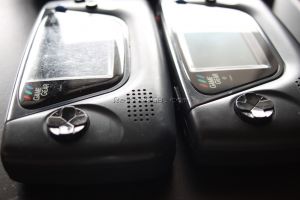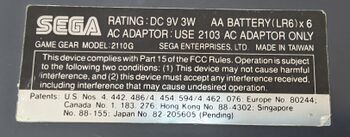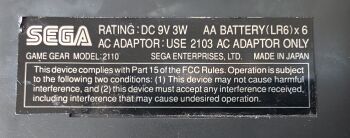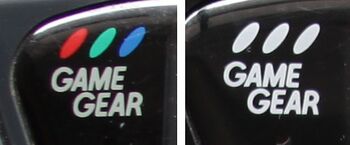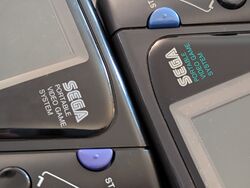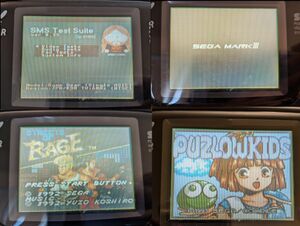Game Gear:Game Gear Model Differences: Difference between revisions
m (Text replacement - "[.][ ][ ]" to ". ") |
No edit summary |
||
| (20 intermediate revisions by 3 users not shown) | |||
| Line 1: | Line 1: | ||
Although the basic design of the Game Gear remained largely the same during its lifespan, there are a number of different revisions which range from simple cosmetic differences to redesigned internals. | |||
=== | == Board Revisions == | ||
=== VA0 (1990-1993, All Regions) === | |||
This is the initial board revision of the Game Gear, and is often known as the "twin ASIC" version as it is the only Game Gear revision to have a separate VDP (Video Display Processor) and SCA (Standard Cell Array), which are two SMD chips located near the speaker. It is also the only Game Gear revision to have a discrete Z80 CPU. | |||
=== | ==== Board Part Numbers ==== | ||
* 837-7398-0x (Japan) | |||
[[File: | * 837-7719-0x (US) | ||
[[File:GGCurvedVsFlat01.jpg|x200px]] | * 837-7996 (Europe) | ||
=== VA1 (1992-1996, All Regions) === | |||
Commonly known as the "single ASIC" board, the VA1 was gradually introduced for all regions during 1992 and totally replaced the VA0 by 1993. In this revision, the Z80, VDP and SCA were combined into a single ASIC (315-5535), reducing production costs. This was the final board revision for Europe and Japan. | |||
VA1 boards began being phased in with the following serial numbers:<ref>https://consolemods.org/wiki/images/2/24/Game_Gear_VA1_Service_Manual.pdf</ref> | |||
* 020019501 (Europe) | |||
* 020168498 (Canada) | |||
* 020176537 (US) | |||
* B20135204 (North America) | |||
* B30000001 (Europe) | |||
* K20117921 (North America) | |||
* K37000001 (Europe) | |||
* P31000001 (North America) | |||
* P31020001 (Europe) | |||
==== Board Part Numbers ==== | |||
* 837-8560 (Japan) | |||
* 837-9024 (North America) | |||
* 837-9130 (Europe) | |||
=== VA4 (1993-1994, North America) === | |||
This unusual revision only appeared in North American systems and uses a different ASIC (315-5682) than the VA1. Some components, namely the audio preamp and video RAM, were also relocated to the front of the board. The LCD used in the VA4 is completely different than the VA0 and VA1, with two smaller ribbon cables coming from the right-hand side of the screen. Screen replacements intended for the VA0 and VA1 are not compatible. Sega also changed the connectors for the power and sound PCBs from AMP CT ones to the more common JST PH type, meaning that power and sound boards from the VA0 and VA1 cannot be used on a VA4 without modification. | |||
Game Gears with this board will have the model number '''2110K''' and always have a "3" as the third digit in the serial number. | |||
=== VA5 / 171-7923A (1994-1996 and 2001, North America) === | |||
On this revision, the audio preamp and video RAM were moved back to the rear of the board and the LCD was changed again, this time using a single ribbon cable as on the VA0 and VA1. Despite this, the VA5 is still incompatible with screen mods intended for the VA0 and VA1. Like the VA4, Sega used JST PH connectors for the power and sound PCBs, so boards from the VA0 and VA1 are still not compatible without modification. | |||
Majesco Game Gears (detailed below) used a slight variant of the VA5 known as the 171-7923A. All Game Gears with a VA5 board, including Majesco units, have the model number '''2110G'''. Original Sega VA5s will also have a "4" as the third digit of the serial number. | |||
== Cosmetic Differences == | |||
=== Colorways === | |||
Although the vast majority of Game Gear units are a dark gray/black color, Sega did offer the Game Gear in different colors for both the Japanese and North American markets. | |||
====Japan==== | |||
In Japan, the first color other than black to be offered was a limited edition white version in 1991. This system came bundled with a matching TV Tuner and hardshell carrying case, and reportedly only about 10,000 units were manufactured.<ref>https://segaretro.org/Game_Gear_consoles_in_Japan</ref> Later in 1994, Sega began selling the Game Gear in multiple colors, including light blue, red, yellow and smoke (clear black). The red variant was also the basis for special Coca-Cola<ref>https://segaretro.org/File:CocaColaGameGear_JP_box_front.jpg</ref> and ''Magic Knight Rayearth''<ref>https://segaretro.org/File:GG_MKR_JP_Box_Front.jpg</ref> themed bundles, with the respective logo for each license printed on the front shell. | |||
By early 1996, Sega handed off marketing and distribution of the Game Gear in Japan to its [https://en.wikipedia.org/wiki/Sega_Fave toy division], who began marketing the system to a younger audience. A special "Kid's Gear" version of the system was released on March 29, 1996, which featured a unique front shell silkscreened with artwork of Akira from the anime adaptation of ''Virtua Fighter''.<ref>https://www.sega.jp/history/hard/gamegear/devices.html</ref> This system also came bundled with ''[https://segaretro.org/Virtua_Fighter_Animation Virtua Fighter Mini]'' and was the last Game Gear variant sold in Japan. | |||
====North America==== | |||
The North American market received a unique blue variant in 1994, which was only available in special bundles with either ''The Lion King''<ref>https://segaretro.org/File:GG_US_Box_Front_LionKing.jpg</ref> or ''World Series Baseball''<ref>https://segaretro.org/File:GG_US_Box_Front_SegaSports.jpg</ref>. This was the only color other than black available outside Japan. | |||
===Conductive Paint=== | |||
On North American and European systems, the inside of the shell was coated with conductive paint in order to reduce EMI. Earlier units have an aluminized coating while later systems use a brown-colored or dark gray paint instead. Japanese systems have bare plastic on the inside and do not have conductive paint. | |||
=== AC Adapters=== | |||
European and Japanese systems use the same tip negative AC adapter as the Master System and model 1 Genesis/Mega Drive, while US systems use the same tip positive EIAJ-03 AC adapter as the model 2 Genesis/Mega Drive. | |||
=== Screen Lens === | |||
Early Game Gears in all regions have a completely flat screen lens, which despite its appearance is made of plastic. During 1991 and 1992, a curved "bubble" lens began being phased in, and this is the type of lens found on most Game Gears. The lens can also be used as a very rough way to determine if a system has a VA0 or VA1 board; systems with a flat lens (assuming it has not been replaced with an aftermarket one) will always have a VA0 board, though some older systems with a bubble lens will also have a VA0 board. | |||
[[File:GGCurvedVsFlat01.jpg|x200px]] | |||
[[File:GGCurvedVsFlat03.jpg|x200px]] | [[File:GGCurvedVsFlat03.jpg|x200px]] | ||
=== TMSS === | |||
During the VA1's production run, Sega began implementing [https://segaretro.org/TradeMark_Security_System TradeMark Security System] functionality, presumably in an attempt to deter unlicensed games as Sega had previously done with the [[Genesis:Genesis Mods Wiki|Genesis/Mega Drive]]. Although the TMSS ROM was always part of the VA1's ASIC, Sega did not start implementing it until 1993. European Game Gears with TMSS also have a different model number, MK-2110-50 instead of 2110-50. TMSS is also present on the VA4 and VA5 board revisions. When it comes to officially licensed cartridges, the presence of TMSS does not cause any game compatibility issues on the Game Gear as it did with the Genesis/Mega Drive. | |||
On all applicable board revisions, the TMSS screen can be disabled by shorting "J1" on the motherboard, and Sega did install a 0 ohm jumper at this location for VA1 units that did not have TMSS.<ref>https://www.smspower.org/forums/10048-GG1ASICBiosSkipModJustBridgeJ1</ref> | |||
{| style="margin: 0 auto;" | |||
|[[Image:GGTMSS.jpg|350px|thumb|upright|The TMSS screen on a Game Gear, which is displayed at boot.]] | |||
|[[Image:USGameGearWithTMSS.jpg|350px|thumb|upright|US Game Gear consoles with TMSS will have a small silver section on their rear label listing various patent numbers...]] | |||
|[[Image:USGameGearNoTMSS.jpg|350px|thumb|upright|...while those without TMSS do not have patent numbers listed.]] | |||
|} | |||
=== Majesco Game Gear === | |||
US-based distributor Majesco rereleased the Game Gear in early 2001, several years after Sega had officially discontinued the system. It was sold for US$29.99<ref>http://www.gamesasylum.com/2014/07/18/majesco-and-the-sega-game-gears-second-lease-of-life/</ref> at Toys 'R Us, Amazon, and discount retailers such as Ames<ref>https://dcemulation.org/phpBB/viewtopic.php?style=1&p=14644&sid=d389f39527363a4f76941b7518422dc3#p14644</ref> and Kmart. These units have a number of cosmetic differences, the most notable being the monochrome ovals on the screen lens (these are tricolored on original run units). The shell is more of a jet black color, the power switch is also black instead of red, the Start button has more of a purplish tinge, and both the serial and model number labels are made of white paper instead of foil. In addition, the threaded hole on the back for securing accessories like the Super Wide Gear and Master Gear Converter is filled in. | |||
All Majesco units have the 171-7923A board revision, which is incompatible with the TV Tuner. Majesco units are generally less susceptible to capacitor leakage, but they are not immune to this common issue and it is still recommended to recap these systems regardless. | |||
An interesting curiosity regarding the Majesco Game Gear is that it is set to the Japanese region setting for Master System games, but Game Gear games behave as they do on an American or European system. | |||
{| style="margin: 0 auto;" | |||
|[[Image:GGSegaVsMajesco.jpg|350px|thumb|upright|Majesco units have a monochrome lens (right) compared to an original unit's multicolored one (left).]] | |||
|[[Image:GGSegaVsMajesco2.jpg|450px|thumb|upright|Original Sega units (left) have foil labels on the back while Majesco units (right) have cheap paper ones instead.]] | |||
|[[Image:MajescoVsSega1.jpg|250px|thumb|upright|Majesco units have the "Portable Video Game System" text in monochrome and the Start button has more of a purple tint than blue.]] | |||
|[[Image:MajescoVsSega2.jpg|250px|thumb|upright|Majesco units have a black power switch while original Sega units have red.]] | |||
|[[Image:MajescoGGRegionWeirdness.jpg|300px|thumb|upright|On a Majesco Game Gear, Master System games behave as if they're being played on a Japanese system but Game Gear games do not.]] | |||
|} | |||
== Links == | |||
https://segaretro.org/Sega_Game_Gear | |||
https://en.wikipedia.org/wiki/Game_Gear | |||
https://www.retrorgb.com/gamegearversions.html | |||
https://console5.com/techwiki/index.php?title=Game_Gear | |||
== References == | |||
[[Category:Game_Gear]] | |||
<references /> | |||
Latest revision as of 00:16, 9 September 2024
Although the basic design of the Game Gear remained largely the same during its lifespan, there are a number of different revisions which range from simple cosmetic differences to redesigned internals.
Board Revisions
VA0 (1990-1993, All Regions)
This is the initial board revision of the Game Gear, and is often known as the "twin ASIC" version as it is the only Game Gear revision to have a separate VDP (Video Display Processor) and SCA (Standard Cell Array), which are two SMD chips located near the speaker. It is also the only Game Gear revision to have a discrete Z80 CPU.
Board Part Numbers
- 837-7398-0x (Japan)
- 837-7719-0x (US)
- 837-7996 (Europe)
VA1 (1992-1996, All Regions)
Commonly known as the "single ASIC" board, the VA1 was gradually introduced for all regions during 1992 and totally replaced the VA0 by 1993. In this revision, the Z80, VDP and SCA were combined into a single ASIC (315-5535), reducing production costs. This was the final board revision for Europe and Japan.
VA1 boards began being phased in with the following serial numbers:[1]
- 020019501 (Europe)
- 020168498 (Canada)
- 020176537 (US)
- B20135204 (North America)
- B30000001 (Europe)
- K20117921 (North America)
- K37000001 (Europe)
- P31000001 (North America)
- P31020001 (Europe)
Board Part Numbers
- 837-8560 (Japan)
- 837-9024 (North America)
- 837-9130 (Europe)
VA4 (1993-1994, North America)
This unusual revision only appeared in North American systems and uses a different ASIC (315-5682) than the VA1. Some components, namely the audio preamp and video RAM, were also relocated to the front of the board. The LCD used in the VA4 is completely different than the VA0 and VA1, with two smaller ribbon cables coming from the right-hand side of the screen. Screen replacements intended for the VA0 and VA1 are not compatible. Sega also changed the connectors for the power and sound PCBs from AMP CT ones to the more common JST PH type, meaning that power and sound boards from the VA0 and VA1 cannot be used on a VA4 without modification.
Game Gears with this board will have the model number 2110K and always have a "3" as the third digit in the serial number.
VA5 / 171-7923A (1994-1996 and 2001, North America)
On this revision, the audio preamp and video RAM were moved back to the rear of the board and the LCD was changed again, this time using a single ribbon cable as on the VA0 and VA1. Despite this, the VA5 is still incompatible with screen mods intended for the VA0 and VA1. Like the VA4, Sega used JST PH connectors for the power and sound PCBs, so boards from the VA0 and VA1 are still not compatible without modification.
Majesco Game Gears (detailed below) used a slight variant of the VA5 known as the 171-7923A. All Game Gears with a VA5 board, including Majesco units, have the model number 2110G. Original Sega VA5s will also have a "4" as the third digit of the serial number.
Cosmetic Differences
Colorways
Although the vast majority of Game Gear units are a dark gray/black color, Sega did offer the Game Gear in different colors for both the Japanese and North American markets.
Japan
In Japan, the first color other than black to be offered was a limited edition white version in 1991. This system came bundled with a matching TV Tuner and hardshell carrying case, and reportedly only about 10,000 units were manufactured.[2] Later in 1994, Sega began selling the Game Gear in multiple colors, including light blue, red, yellow and smoke (clear black). The red variant was also the basis for special Coca-Cola[3] and Magic Knight Rayearth[4] themed bundles, with the respective logo for each license printed on the front shell.
By early 1996, Sega handed off marketing and distribution of the Game Gear in Japan to its toy division, who began marketing the system to a younger audience. A special "Kid's Gear" version of the system was released on March 29, 1996, which featured a unique front shell silkscreened with artwork of Akira from the anime adaptation of Virtua Fighter.[5] This system also came bundled with Virtua Fighter Mini and was the last Game Gear variant sold in Japan.
North America
The North American market received a unique blue variant in 1994, which was only available in special bundles with either The Lion King[6] or World Series Baseball[7]. This was the only color other than black available outside Japan.
Conductive Paint
On North American and European systems, the inside of the shell was coated with conductive paint in order to reduce EMI. Earlier units have an aluminized coating while later systems use a brown-colored or dark gray paint instead. Japanese systems have bare plastic on the inside and do not have conductive paint.
AC Adapters
European and Japanese systems use the same tip negative AC adapter as the Master System and model 1 Genesis/Mega Drive, while US systems use the same tip positive EIAJ-03 AC adapter as the model 2 Genesis/Mega Drive.
Screen Lens
Early Game Gears in all regions have a completely flat screen lens, which despite its appearance is made of plastic. During 1991 and 1992, a curved "bubble" lens began being phased in, and this is the type of lens found on most Game Gears. The lens can also be used as a very rough way to determine if a system has a VA0 or VA1 board; systems with a flat lens (assuming it has not been replaced with an aftermarket one) will always have a VA0 board, though some older systems with a bubble lens will also have a VA0 board.
TMSS
During the VA1's production run, Sega began implementing TradeMark Security System functionality, presumably in an attempt to deter unlicensed games as Sega had previously done with the Genesis/Mega Drive. Although the TMSS ROM was always part of the VA1's ASIC, Sega did not start implementing it until 1993. European Game Gears with TMSS also have a different model number, MK-2110-50 instead of 2110-50. TMSS is also present on the VA4 and VA5 board revisions. When it comes to officially licensed cartridges, the presence of TMSS does not cause any game compatibility issues on the Game Gear as it did with the Genesis/Mega Drive.
On all applicable board revisions, the TMSS screen can be disabled by shorting "J1" on the motherboard, and Sega did install a 0 ohm jumper at this location for VA1 units that did not have TMSS.[8]
Majesco Game Gear
US-based distributor Majesco rereleased the Game Gear in early 2001, several years after Sega had officially discontinued the system. It was sold for US$29.99[9] at Toys 'R Us, Amazon, and discount retailers such as Ames[10] and Kmart. These units have a number of cosmetic differences, the most notable being the monochrome ovals on the screen lens (these are tricolored on original run units). The shell is more of a jet black color, the power switch is also black instead of red, the Start button has more of a purplish tinge, and both the serial and model number labels are made of white paper instead of foil. In addition, the threaded hole on the back for securing accessories like the Super Wide Gear and Master Gear Converter is filled in.
All Majesco units have the 171-7923A board revision, which is incompatible with the TV Tuner. Majesco units are generally less susceptible to capacitor leakage, but they are not immune to this common issue and it is still recommended to recap these systems regardless.
An interesting curiosity regarding the Majesco Game Gear is that it is set to the Japanese region setting for Master System games, but Game Gear games behave as they do on an American or European system.
Links
https://segaretro.org/Sega_Game_Gear
https://en.wikipedia.org/wiki/Game_Gear
https://www.retrorgb.com/gamegearversions.html
https://console5.com/techwiki/index.php?title=Game_Gear
References
- ↑ https://consolemods.org/wiki/images/2/24/Game_Gear_VA1_Service_Manual.pdf
- ↑ https://segaretro.org/Game_Gear_consoles_in_Japan
- ↑ https://segaretro.org/File:CocaColaGameGear_JP_box_front.jpg
- ↑ https://segaretro.org/File:GG_MKR_JP_Box_Front.jpg
- ↑ https://www.sega.jp/history/hard/gamegear/devices.html
- ↑ https://segaretro.org/File:GG_US_Box_Front_LionKing.jpg
- ↑ https://segaretro.org/File:GG_US_Box_Front_SegaSports.jpg
- ↑ https://www.smspower.org/forums/10048-GG1ASICBiosSkipModJustBridgeJ1
- ↑ http://www.gamesasylum.com/2014/07/18/majesco-and-the-sega-game-gears-second-lease-of-life/
- ↑ https://dcemulation.org/phpBB/viewtopic.php?style=1&p=14644&sid=d389f39527363a4f76941b7518422dc3#p14644

